【原创】专题05 名词的数专项训练100题(含解析)-2025中考英语二轮专题复习(答题技巧+题目分类与分层)
文档属性
| 名称 | 【原创】专题05 名词的数专项训练100题(含解析)-2025中考英语二轮专题复习(答题技巧+题目分类与分层) | 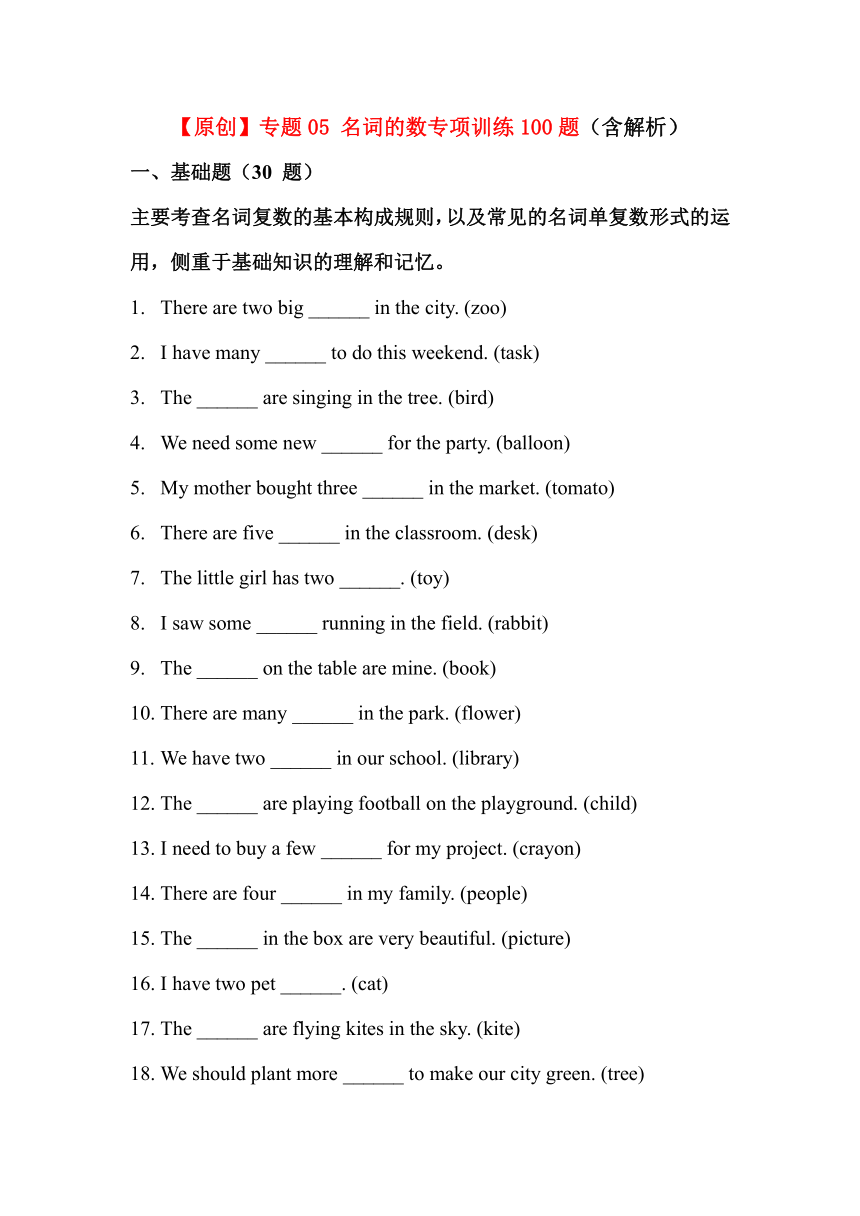 | |
| 格式 | docx | ||
| 文件大小 | 21.2KB | ||
| 资源类型 | 试卷 | ||
| 版本资源 | 人教新目标(Go for it)版 | ||
| 科目 | 英语 | ||
| 更新时间 | 2025-02-28 16:30:22 | ||
图片预览

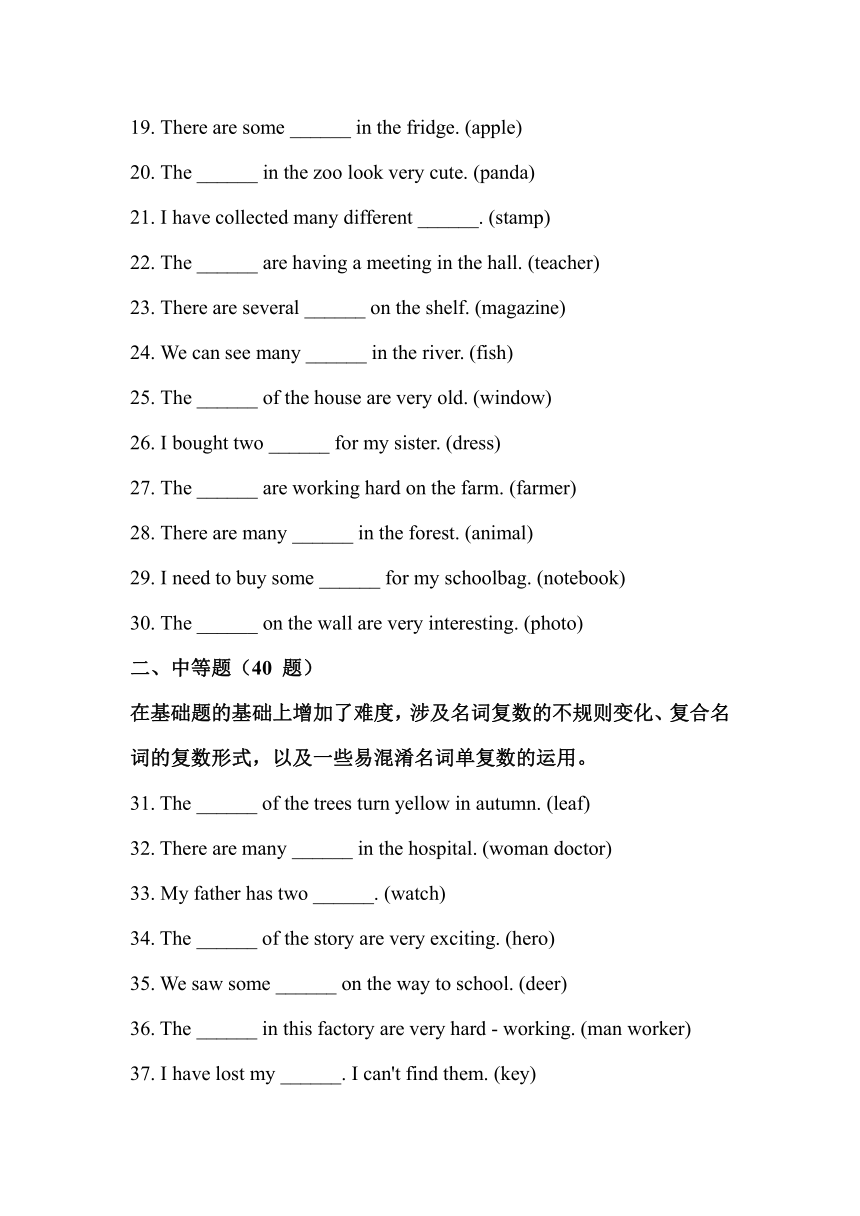
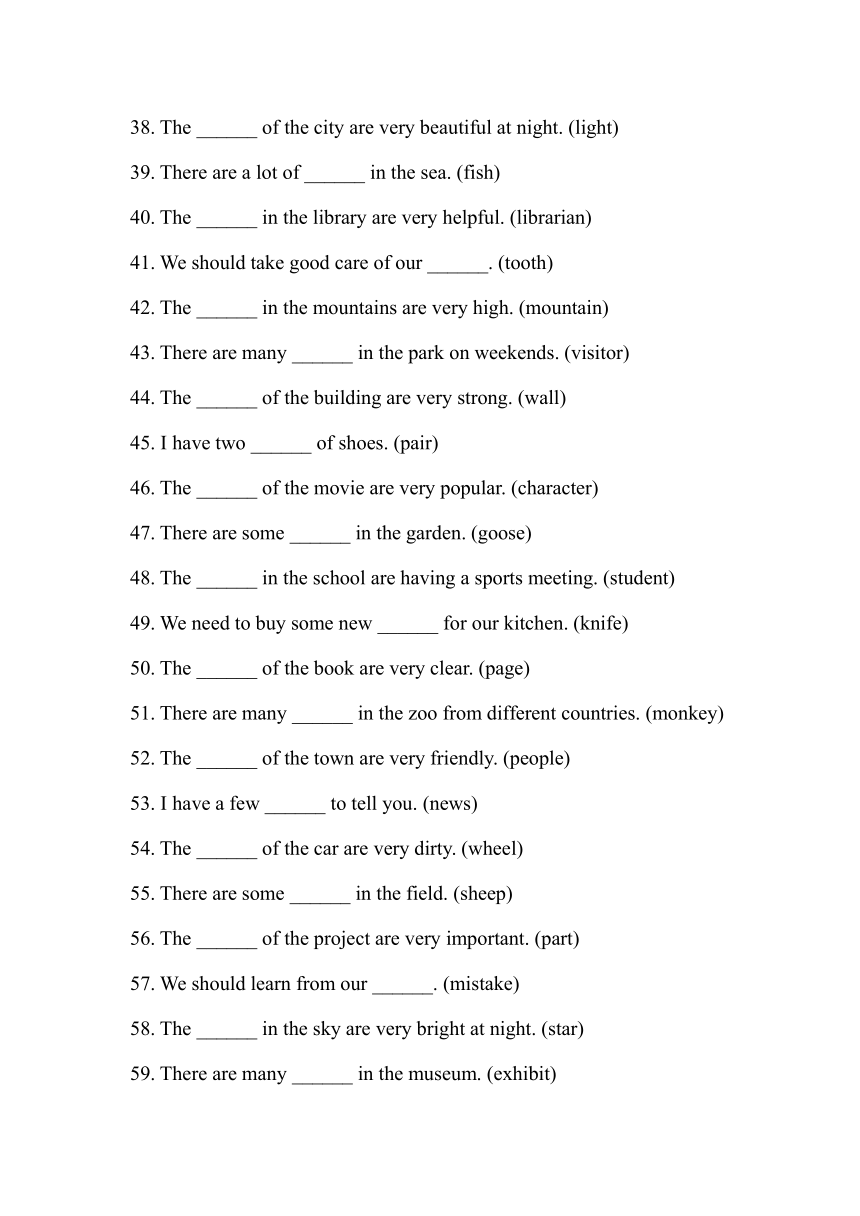
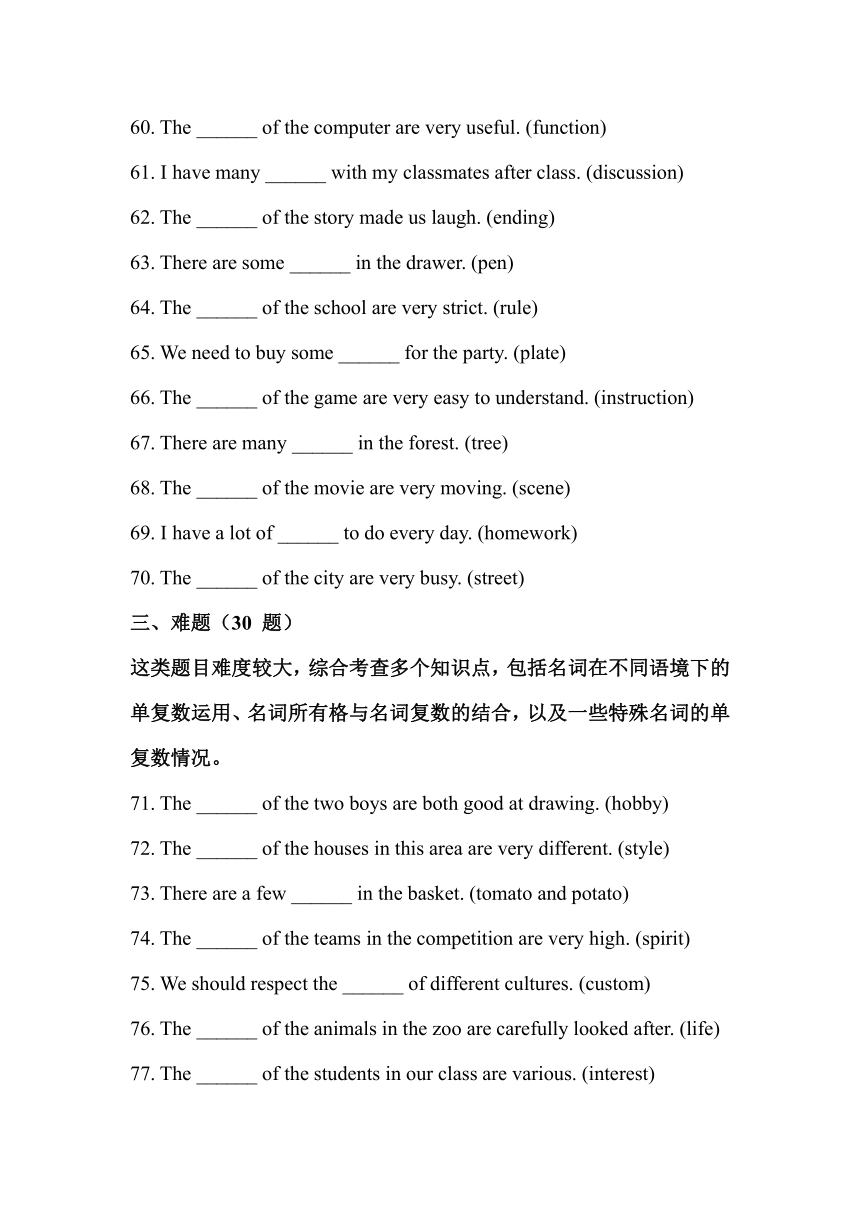
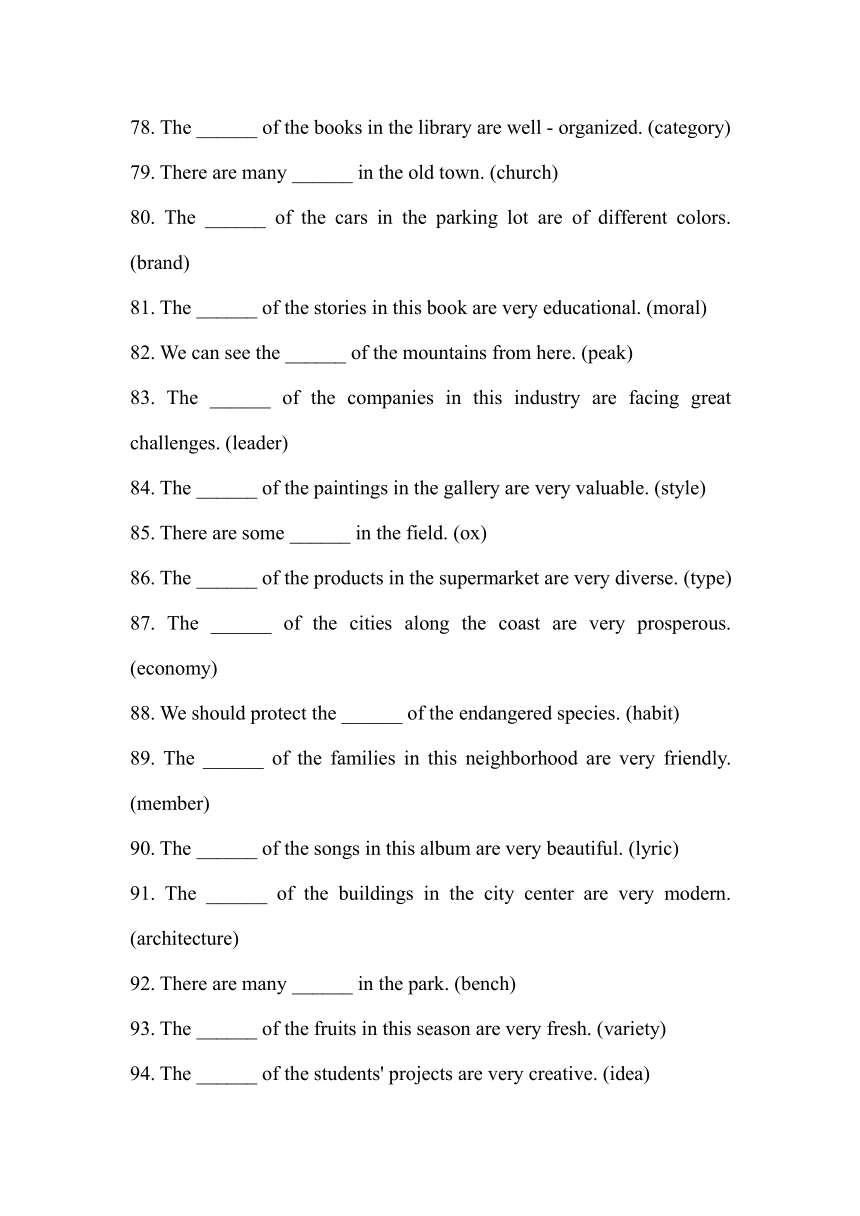
文档简介
【原创】专题05 名词的数专项训练100题(含解析)
一、基础题(30 题)
主要考查名词复数的基本构成规则,以及常见的名词单复数形式的运用,侧重于基础知识的理解和记忆。
There are two big ______ in the city. (zoo)
I have many ______ to do this weekend. (task)
The ______ are singing in the tree. (bird)
We need some new ______ for the party. (balloon)
My mother bought three ______ in the market. (tomato)
There are five ______ in the classroom. (desk)
The little girl has two ______. (toy)
I saw some ______ running in the field. (rabbit)
The ______ on the table are mine. (book)
There are many ______ in the park. (flower)
We have two ______ in our school. (library)
The ______ are playing football on the playground. (child)
I need to buy a few ______ for my project. (crayon)
There are four ______ in my family. (people)
The ______ in the box are very beautiful. (picture)
I have two pet ______. (cat)
The ______ are flying kites in the sky. (kite)
We should plant more ______ to make our city green. (tree)
There are some ______ in the fridge. (apple)
The ______ in the zoo look very cute. (panda)
I have collected many different ______. (stamp)
The ______ are having a meeting in the hall. (teacher)
There are several ______ on the shelf. (magazine)
We can see many ______ in the river. (fish)
The ______ of the house are very old. (window)
I bought two ______ for my sister. (dress)
The ______ are working hard on the farm. (farmer)
There are many ______ in the forest. (animal)
I need to buy some ______ for my schoolbag. (notebook)
The ______ on the wall are very interesting. (photo)
二、中等题(40 题)
在基础题的基础上增加了难度,涉及名词复数的不规则变化、复合名词的复数形式,以及一些易混淆名词单复数的运用。
31. The ______ of the trees turn yellow in autumn. (leaf)
32. There are many ______ in the hospital. (woman doctor)
33. My father has two ______. (watch)
34. The ______ of the story are very exciting. (hero)
35. We saw some ______ on the way to school. (deer)
36. The ______ in this factory are very hard - working. (man worker)
37. I have lost my ______. I can't find them. (key)
38. The ______ of the city are very beautiful at night. (light)
39. There are a lot of ______ in the sea. (fish)
40. The ______ in the library are very helpful. (librarian)
41. We should take good care of our ______. (tooth)
42. The ______ in the mountains are very high. (mountain)
43. There are many ______ in the park on weekends. (visitor)
44. The ______ of the building are very strong. (wall)
45. I have two ______ of shoes. (pair)
46. The ______ of the movie are very popular. (character)
47. There are some ______ in the garden. (goose)
48. The ______ in the school are having a sports meeting. (student)
49. We need to buy some new ______ for our kitchen. (knife)
50. The ______ of the book are very clear. (page)
51. There are many ______ in the zoo from different countries. (monkey)
52. The ______ of the town are very friendly. (people)
53. I have a few ______ to tell you. (news)
54. The ______ of the car are very dirty. (wheel)
55. There are some ______ in the field. (sheep)
56. The ______ of the project are very important. (part)
57. We should learn from our ______. (mistake)
58. The ______ in the sky are very bright at night. (star)
59. There are many ______ in the museum. (exhibit)
60. The ______ of the computer are very useful. (function)
61. I have many ______ with my classmates after class. (discussion)
62. The ______ of the story made us laugh. (ending)
63. There are some ______ in the drawer. (pen)
64. The ______ of the school are very strict. (rule)
65. We need to buy some ______ for the party. (plate)
66. The ______ of the game are very easy to understand. (instruction)
67. There are many ______ in the forest. (tree)
68. The ______ of the movie are very moving. (scene)
69. I have a lot of ______ to do every day. (homework)
70. The ______ of the city are very busy. (street)
三、难题(30 题)
这类题目难度较大,综合考查多个知识点,包括名词在不同语境下的单复数运用、名词所有格与名词复数的结合,以及一些特殊名词的单复数情况。
71. The ______ of the two boys are both good at drawing. (hobby)
72. The ______ of the houses in this area are very different. (style)
73. There are a few ______ in the basket. (tomato and potato)
74. The ______ of the teams in the competition are very high. (spirit)
75. We should respect the ______ of different cultures. (custom)
76. The ______ of the animals in the zoo are carefully looked after. (life)
77. The ______ of the students in our class are various. (interest)
78. The ______ of the books in the library are well - organized. (category)
79. There are many ______ in the old town. (church)
80. The ______ of the cars in the parking lot are of different colors. (brand)
81. The ______ of the stories in this book are very educational. (moral)
82. We can see the ______ of the mountains from here. (peak)
83. The ______ of the companies in this industry are facing great challenges. (leader)
84. The ______ of the paintings in the gallery are very valuable. (style)
85. There are some ______ in the field. (ox)
86. The ______ of the products in the supermarket are very diverse. (type)
87. The ______ of the cities along the coast are very prosperous. (economy)
88. We should protect the ______ of the endangered species. (habit)
89. The ______ of the families in this neighborhood are very friendly. (member)
90. The ______ of the songs in this album are very beautiful. (lyric)
91. The ______ of the buildings in the city center are very modern. (architecture)
92. There are many ______ in the park. (bench)
93. The ______ of the fruits in this season are very fresh. (variety)
94. The ______ of the students' projects are very creative. (idea)
95. We should learn from the ______ of the great people. (experience)
96. The ______ of the flowers in the garden are very colorful. (color)
97. The ______ of the cars on the road are very fast. (speed)
98. The ______ of the books on the shelf are very interesting. (content)
99. There are some ______ in the pond. (duck)
100. The ______ of the movies in this theater are very popular. (plot)
答案解析
(一)基础题答案解析
zoos:“zoo” 的复数形式是直接加 “s”,“two big zoos” 表示 “两个大动物园” 。
tasks:“task” 是可数名词,“many” 修饰可数名词复数,所以用 “tasks”。
birds:“bird” 的复数形式是 “birds”,“are singing” 表明主语是复数。
balloons:“balloon” 的复数直接加 “s”,“some new balloons” 表示 “一些新气球”。
tomatoes:“tomato” 的复数形式是加 “es”,即 “tomatoes”。
desks:“desk” 的复数形式为 “desks”,“five desks” 表示 “五张桌子”。
toys:“toy” 的复数是直接加 “s”,“two toys” 表示 “两个玩具”。
rabbits:“rabbit” 的复数形式是 “rabbits”,“some rabbits” 表示 “一些兔子”。
books:“book” 的复数直接加 “s”,“The books on the table” 表示 “桌子上的书”。
flowers:“flower” 的复数形式是 “flowers”,“many flowers” 表示 “许多花”。
libraries:“library” 以 “辅音字母 + y” 结尾,复数形式变 “y” 为 “i” 再加 “es”,即 “libraries”。
children:“child” 的复数形式是不规则变化 “children”。
crayons:“crayon” 的复数直接加 “s”,“a few crayons” 表示 “一些蜡笔”。
people:“people” 本身就是复数形式,表示 “人;人们”,“four people” 表示 “四个人”。
pictures:“picture” 的复数形式是 “pictures”,“The pictures in the box” 表示 “盒子里的图片”。
cats:“cat” 的复数直接加 “s” ,“two pet cats” 表示 “两只宠物猫”。
kites:“kite” 的复数形式是 “kites”,“The kites are flying” 表示 “风筝在飞”。
trees:“tree” 的复数直接加 “s”,“plant more trees” 表示 “种更多的树”。
apples:“apple” 的复数形式是 “apples”,“some apples” 表示 “一些苹果”。
pandas:“panda” 的复数直接加 “s”,“The pandas in the zoo” 表示 “动物园里的熊猫”。
stamps:“stamp” 的复数形式是 “stamps”,“many different stamps” 表示 “许多不同的邮票”。
teachers:“teacher” 的复数直接加 “s”,“The teachers are having a meeting” 表示 “老师们正在开会”。
magazines:“magazine” 的复数直接加 “s”,“several magazines” 表示 “几本杂志”。
fish:“fish” 单复数同形,“many fish” 表示 “许多鱼” 。
windows:“window” 的复数形式是 “windows”,“The windows of the house” 表示 “房子的窗户”。
dresses:“dress” 的复数形式是加 “es”,“two dresses” 表示 “两条连衣裙”。
farmers:“farmer” 的复数直接加 “s”,“The farmers are working” 表示 “农民们正在劳作”。
animals:“animal” 的复数形式是 “animals”,“many animals” 表示 “许多动物”。
notebooks:“notebook” 的复数直接加 “s”,“some notebooks” 表示 “一些笔记本”。
photos:“photo” 的复数形式是直接加 “s”,“The photos on the wall” 表示 “墙上的照片”。
(二)中等题答案解析
leaves:“leaf” 的复数形式是不规则变化 “leaves”,“The leaves of the trees” 表示 “树的叶子”。
women doctors:“woman doctor” 变复数时,“woman” 和 “doctor” 都要变为复数形式,即 “women doctors”。
watches:“watch” 以 “ch” 结尾,复数形式加 “es”,“two watches” 表示 “两块手表”。
heroes:“hero” 的复数形式是加 “es”,“The heroes of the story” 表示 “故事中的英雄们”。
deer:“deer” 单复数同形,“some deer” 表示 “一些鹿”。
men workers:“man worker” 变复数时,“man” 和 “worker” 都要变为复数形式,即 “men workers”。
keys:“key” 的复数形式是直接加 “s”,“I have lost my keys” 表示 “我丢了我的钥匙”。
lights:“light” 的复数形式是 “lights”,“The lights of the city” 表示 “城市的灯光”。
fish/fishes:当 “fish” 指不同种类的鱼时,复数形式可以用 “fishes”;指鱼的数量时,单复数同形,这里 “a lot of fish” 既可以表示很多条鱼,也可以表示很多种鱼 。
librarians:“librarian” 的复数形式是直接加 “s”,“The librarians in the library” 表示 “图书馆里的图书管理员们”。
teeth:“tooth” 的复数形式是不规则变化 “teeth”,“take good care of our teeth” 表示 “保护好我们的牙齿”。
mountains:“mountain” 的复数形式是直接加 “s”,“The mountains in the mountains” 表示 “山里的山”。
visitors:“visitor” 的复数形式是直接加 “s”,“many visitors” 表示 “许多游客”。
walls:“wall” 的复数形式是 “walls”,“The walls of the building” 表示 “建筑物的墙”。
pairs:“pair” 的复数形式是 “pairs”,“two pairs of shoes” 表示 “两双鞋”。
characters:“character” 的复数形式是直接加 “s”,“The characters of the movie” 表示 “电影中的角色”。
geese:“goose” 的复数形式是不规则变化 “geese”,“some geese” 表示 “一些鹅”。
students:“student” 的复数形式是直接加 “s”,“The students in the school” 表示 “学校里的学生们”。
knives:“knife” 以 “fe” 结尾,复数形式变 “fe” 为 “v” 再加 “es”,即 “knives”。
pages:“page” 的复数形式是直接加 “s”,“The pages of the book” 表示 “书的页面”。
monkeys:“monkey” 的复数形式是直接加 “s”,“many monkeys” 表示 “许多猴子”。
people:“people” 本身是复数形式,“The people of the town” 表示 “镇上的人们”。
pieces of news:“news” 是不可数名词,“a few pieces of news” 表示 “几条新闻” 。
wheels:“wheel” 的复数形式是 “wheels”,“The wheels of the car” 表示 “汽车的轮子”。
sheep:“sheep” 单复数同形,“some sheep” 表示 “一些羊”。
parts:“part” 的复数形式是直接加 “s”,“The parts of the project” 表示 “项目的部分”。
mistakes:“mistake” 的复数形式是 “mistakes”,“learn from our mistakes” 表示 “从我们的错误中学习”。
stars:“star” 的复数形式是 “stars”,“The stars in the sky” 表示 “天空中的星星”。
exhibits:“exhibit” 的复数形式是直接加 “s”,“many exhibits” 表示 “许多展品”。
functions:“function” 的复数形式是直接加 “s”,“The functions of the computer” 表示 “计算机的功能”。
discussions:“discussion” 的复数形式是直接加 “s”,“have many discussions” 表示 “进行许多讨论”。
endings:“ending” 的复数形式是直接加 “s”,“The endings of the story” 表示 “故事的结局”。
pens:“pen” 的复数形式是直接加 “s”,“some pens” 表示 “一些钢笔” 。
rules:“rule” 的复数形式为 “rules”,“The rules of the school” 表示 “学校的规定” 。
plates:“plate” 的复数直接加 “s”,“buy some plates” 表示 “买一些盘子” 。
instructions:“instruction” 的复数形式是 “instructions” ,“The instructions of the game” 表示 “游戏的说明”。
trees:“tree” 的复数形式是 “trees”,“many trees” 表示 “许多树” 。
scenes:“scene” 的复数形式为 “scenes”,“The scenes of the movie” 表示 “电影的场景” 。
homework:“homework” 是不可数名词,没有复数形式,“a lot of homework” 表示 “许多家庭作业” 。
streets:“street” 的复数形式是 “streets”,“The streets of the city” 表示 “城市的街道” 。
(三)难题答案解析
hobbies:“hobby” 以 “辅音字母 + y” 结尾,复数形式变 “y” 为 “i” 再加 “es”,“The hobbies of the two boys” 表示 “这两个男孩的爱好” 。
styles:“style” 的复数形式是直接加 “s”,“The styles of the houses” 表示 “这些房子的风格” 。
tomatoes and potatoes:“tomato” 和 “potato” 的复数形式都要加 “es”,“a few tomatoes and potatoes” 表示 “一些西红柿和土豆” 。
spirits:“spirit” 在这里表示 “精神风貌”,常用复数形式,“The spirits of the teams” 表示 “各队的精神风貌” 。
customs:“custom” 表示 “习俗” 时常用复数形式,“the customs of different cultures” 表示 “不同文化的习俗” 。
lives:“life” 表示 “生命” 时,复数形式为 “lives”,“The lives of the animals” 表示 “动物们的生命” 。
interests:“interest” 表示 “兴趣” 时,是可数名词,复数形式为 “interests”,“The interests of the students” 表示 “学生们的兴趣” 。
categories:“category” 的复数形式是变 “y” 为 “i” 再加 “es”,“The categories of the books” 表示 “书籍的类别” 。
churches:“church” 以 “ch” 结尾,复数形式加 “es”,“many churches” 表示 “许多教堂” 。
brands:“brand” 的复数形式是直接加 “s”,“The brands of the cars” 表示 “汽车的品牌” 。
morals:“moral” 的复数形式是 “morals”,“The morals of the stories” 表示 “故事的寓意” 。
peaks:“peak” 的复数形式是直接加 “s”,“The peaks of the mountains” 表示 “山脉的山峰” 。
leaders:“leader” 的复数形式是直接加 “s”,“The leaders of the companies” 表示 “这些公司的领导们” 。
styles:“style” 的复数形式是直接加 “s”,“The styles of the paintings” 表示 “这些画作的风格” 。
oxen:“ox” 的复数形式是不规则变化 “oxen”,“some oxen” 表示 “一些牛” 。
types:“type” 的复数形式是直接加 “s”,“The types of the products” 表示 “产品的种类” 。
economies:“economy” 表示 “经济体;经济情况” 时,复数形式是 “economies”,“The economies of the cities” 表示 “这些城市的经济” 。
habitats:“habit” 表示 “习性” 时,复数形式为 “habits”,但这里表示 “栖息地”,复数形式是 “habitats”,“protect the habitats of the endangered species” 表示 “保护濒危物种的栖息地” 。
members:“member” 的复数形式是直接加 “s”,“The members of the families” 表示 “这些家庭的成员” 。
lyrics:“lyric” 表示 “歌词” 时,常用复数形式 “lyrics”,“The lyrics of the songs” 表示 “这些歌曲的歌词” 。
architectures:“architecture” 表示 “建筑风格;建筑式样” 时,复数形式是 “architectures”,“The architectures of the buildings” 表示 “这些建筑物的建筑风格” 。
benches:“bench” 以 “ch” 结尾,复数形式加 “es”,“many benches” 表示 “许多长椅” 。
varieties:“variety” 的复数形式是 “varieties”,“The varieties of the fruits” 表示 “水果的种类” 。
ideas:“idea” 的复数形式是直接加 “s”,“The ideas of the students' projects” 表示 “学生项目的想法” 。
experiences:“experience” 表示 “经历” 时是可数名词,复数形式为 “experiences”,“learn from the experiences of the great people” 表示 “从伟人的经历中学习” 。
colors:“color” 的复数形式是直接加 “s”,“The colors of the flowers” 表示 “花朵的颜色” 。
speeds:“speed” 的复数形式是 “speeds”,“The speeds of the cars” 表示 “汽车的速度” 。
contents:“content” 表示 “内容” 时,常用复数形式 “contents”,“The contents of the books” 表示 “书籍的内容” 。
ducks:“duck” 的复数形式是直接加 “s”,“some ducks” 表示 “一些鸭子” 。
plots:“plot” 的复数形式是直接加 “s”,“The plots of the movies” 表示 “这些电影的情节” 。
一、基础题(30 题)
主要考查名词复数的基本构成规则,以及常见的名词单复数形式的运用,侧重于基础知识的理解和记忆。
There are two big ______ in the city. (zoo)
I have many ______ to do this weekend. (task)
The ______ are singing in the tree. (bird)
We need some new ______ for the party. (balloon)
My mother bought three ______ in the market. (tomato)
There are five ______ in the classroom. (desk)
The little girl has two ______. (toy)
I saw some ______ running in the field. (rabbit)
The ______ on the table are mine. (book)
There are many ______ in the park. (flower)
We have two ______ in our school. (library)
The ______ are playing football on the playground. (child)
I need to buy a few ______ for my project. (crayon)
There are four ______ in my family. (people)
The ______ in the box are very beautiful. (picture)
I have two pet ______. (cat)
The ______ are flying kites in the sky. (kite)
We should plant more ______ to make our city green. (tree)
There are some ______ in the fridge. (apple)
The ______ in the zoo look very cute. (panda)
I have collected many different ______. (stamp)
The ______ are having a meeting in the hall. (teacher)
There are several ______ on the shelf. (magazine)
We can see many ______ in the river. (fish)
The ______ of the house are very old. (window)
I bought two ______ for my sister. (dress)
The ______ are working hard on the farm. (farmer)
There are many ______ in the forest. (animal)
I need to buy some ______ for my schoolbag. (notebook)
The ______ on the wall are very interesting. (photo)
二、中等题(40 题)
在基础题的基础上增加了难度,涉及名词复数的不规则变化、复合名词的复数形式,以及一些易混淆名词单复数的运用。
31. The ______ of the trees turn yellow in autumn. (leaf)
32. There are many ______ in the hospital. (woman doctor)
33. My father has two ______. (watch)
34. The ______ of the story are very exciting. (hero)
35. We saw some ______ on the way to school. (deer)
36. The ______ in this factory are very hard - working. (man worker)
37. I have lost my ______. I can't find them. (key)
38. The ______ of the city are very beautiful at night. (light)
39. There are a lot of ______ in the sea. (fish)
40. The ______ in the library are very helpful. (librarian)
41. We should take good care of our ______. (tooth)
42. The ______ in the mountains are very high. (mountain)
43. There are many ______ in the park on weekends. (visitor)
44. The ______ of the building are very strong. (wall)
45. I have two ______ of shoes. (pair)
46. The ______ of the movie are very popular. (character)
47. There are some ______ in the garden. (goose)
48. The ______ in the school are having a sports meeting. (student)
49. We need to buy some new ______ for our kitchen. (knife)
50. The ______ of the book are very clear. (page)
51. There are many ______ in the zoo from different countries. (monkey)
52. The ______ of the town are very friendly. (people)
53. I have a few ______ to tell you. (news)
54. The ______ of the car are very dirty. (wheel)
55. There are some ______ in the field. (sheep)
56. The ______ of the project are very important. (part)
57. We should learn from our ______. (mistake)
58. The ______ in the sky are very bright at night. (star)
59. There are many ______ in the museum. (exhibit)
60. The ______ of the computer are very useful. (function)
61. I have many ______ with my classmates after class. (discussion)
62. The ______ of the story made us laugh. (ending)
63. There are some ______ in the drawer. (pen)
64. The ______ of the school are very strict. (rule)
65. We need to buy some ______ for the party. (plate)
66. The ______ of the game are very easy to understand. (instruction)
67. There are many ______ in the forest. (tree)
68. The ______ of the movie are very moving. (scene)
69. I have a lot of ______ to do every day. (homework)
70. The ______ of the city are very busy. (street)
三、难题(30 题)
这类题目难度较大,综合考查多个知识点,包括名词在不同语境下的单复数运用、名词所有格与名词复数的结合,以及一些特殊名词的单复数情况。
71. The ______ of the two boys are both good at drawing. (hobby)
72. The ______ of the houses in this area are very different. (style)
73. There are a few ______ in the basket. (tomato and potato)
74. The ______ of the teams in the competition are very high. (spirit)
75. We should respect the ______ of different cultures. (custom)
76. The ______ of the animals in the zoo are carefully looked after. (life)
77. The ______ of the students in our class are various. (interest)
78. The ______ of the books in the library are well - organized. (category)
79. There are many ______ in the old town. (church)
80. The ______ of the cars in the parking lot are of different colors. (brand)
81. The ______ of the stories in this book are very educational. (moral)
82. We can see the ______ of the mountains from here. (peak)
83. The ______ of the companies in this industry are facing great challenges. (leader)
84. The ______ of the paintings in the gallery are very valuable. (style)
85. There are some ______ in the field. (ox)
86. The ______ of the products in the supermarket are very diverse. (type)
87. The ______ of the cities along the coast are very prosperous. (economy)
88. We should protect the ______ of the endangered species. (habit)
89. The ______ of the families in this neighborhood are very friendly. (member)
90. The ______ of the songs in this album are very beautiful. (lyric)
91. The ______ of the buildings in the city center are very modern. (architecture)
92. There are many ______ in the park. (bench)
93. The ______ of the fruits in this season are very fresh. (variety)
94. The ______ of the students' projects are very creative. (idea)
95. We should learn from the ______ of the great people. (experience)
96. The ______ of the flowers in the garden are very colorful. (color)
97. The ______ of the cars on the road are very fast. (speed)
98. The ______ of the books on the shelf are very interesting. (content)
99. There are some ______ in the pond. (duck)
100. The ______ of the movies in this theater are very popular. (plot)
答案解析
(一)基础题答案解析
zoos:“zoo” 的复数形式是直接加 “s”,“two big zoos” 表示 “两个大动物园” 。
tasks:“task” 是可数名词,“many” 修饰可数名词复数,所以用 “tasks”。
birds:“bird” 的复数形式是 “birds”,“are singing” 表明主语是复数。
balloons:“balloon” 的复数直接加 “s”,“some new balloons” 表示 “一些新气球”。
tomatoes:“tomato” 的复数形式是加 “es”,即 “tomatoes”。
desks:“desk” 的复数形式为 “desks”,“five desks” 表示 “五张桌子”。
toys:“toy” 的复数是直接加 “s”,“two toys” 表示 “两个玩具”。
rabbits:“rabbit” 的复数形式是 “rabbits”,“some rabbits” 表示 “一些兔子”。
books:“book” 的复数直接加 “s”,“The books on the table” 表示 “桌子上的书”。
flowers:“flower” 的复数形式是 “flowers”,“many flowers” 表示 “许多花”。
libraries:“library” 以 “辅音字母 + y” 结尾,复数形式变 “y” 为 “i” 再加 “es”,即 “libraries”。
children:“child” 的复数形式是不规则变化 “children”。
crayons:“crayon” 的复数直接加 “s”,“a few crayons” 表示 “一些蜡笔”。
people:“people” 本身就是复数形式,表示 “人;人们”,“four people” 表示 “四个人”。
pictures:“picture” 的复数形式是 “pictures”,“The pictures in the box” 表示 “盒子里的图片”。
cats:“cat” 的复数直接加 “s” ,“two pet cats” 表示 “两只宠物猫”。
kites:“kite” 的复数形式是 “kites”,“The kites are flying” 表示 “风筝在飞”。
trees:“tree” 的复数直接加 “s”,“plant more trees” 表示 “种更多的树”。
apples:“apple” 的复数形式是 “apples”,“some apples” 表示 “一些苹果”。
pandas:“panda” 的复数直接加 “s”,“The pandas in the zoo” 表示 “动物园里的熊猫”。
stamps:“stamp” 的复数形式是 “stamps”,“many different stamps” 表示 “许多不同的邮票”。
teachers:“teacher” 的复数直接加 “s”,“The teachers are having a meeting” 表示 “老师们正在开会”。
magazines:“magazine” 的复数直接加 “s”,“several magazines” 表示 “几本杂志”。
fish:“fish” 单复数同形,“many fish” 表示 “许多鱼” 。
windows:“window” 的复数形式是 “windows”,“The windows of the house” 表示 “房子的窗户”。
dresses:“dress” 的复数形式是加 “es”,“two dresses” 表示 “两条连衣裙”。
farmers:“farmer” 的复数直接加 “s”,“The farmers are working” 表示 “农民们正在劳作”。
animals:“animal” 的复数形式是 “animals”,“many animals” 表示 “许多动物”。
notebooks:“notebook” 的复数直接加 “s”,“some notebooks” 表示 “一些笔记本”。
photos:“photo” 的复数形式是直接加 “s”,“The photos on the wall” 表示 “墙上的照片”。
(二)中等题答案解析
leaves:“leaf” 的复数形式是不规则变化 “leaves”,“The leaves of the trees” 表示 “树的叶子”。
women doctors:“woman doctor” 变复数时,“woman” 和 “doctor” 都要变为复数形式,即 “women doctors”。
watches:“watch” 以 “ch” 结尾,复数形式加 “es”,“two watches” 表示 “两块手表”。
heroes:“hero” 的复数形式是加 “es”,“The heroes of the story” 表示 “故事中的英雄们”。
deer:“deer” 单复数同形,“some deer” 表示 “一些鹿”。
men workers:“man worker” 变复数时,“man” 和 “worker” 都要变为复数形式,即 “men workers”。
keys:“key” 的复数形式是直接加 “s”,“I have lost my keys” 表示 “我丢了我的钥匙”。
lights:“light” 的复数形式是 “lights”,“The lights of the city” 表示 “城市的灯光”。
fish/fishes:当 “fish” 指不同种类的鱼时,复数形式可以用 “fishes”;指鱼的数量时,单复数同形,这里 “a lot of fish” 既可以表示很多条鱼,也可以表示很多种鱼 。
librarians:“librarian” 的复数形式是直接加 “s”,“The librarians in the library” 表示 “图书馆里的图书管理员们”。
teeth:“tooth” 的复数形式是不规则变化 “teeth”,“take good care of our teeth” 表示 “保护好我们的牙齿”。
mountains:“mountain” 的复数形式是直接加 “s”,“The mountains in the mountains” 表示 “山里的山”。
visitors:“visitor” 的复数形式是直接加 “s”,“many visitors” 表示 “许多游客”。
walls:“wall” 的复数形式是 “walls”,“The walls of the building” 表示 “建筑物的墙”。
pairs:“pair” 的复数形式是 “pairs”,“two pairs of shoes” 表示 “两双鞋”。
characters:“character” 的复数形式是直接加 “s”,“The characters of the movie” 表示 “电影中的角色”。
geese:“goose” 的复数形式是不规则变化 “geese”,“some geese” 表示 “一些鹅”。
students:“student” 的复数形式是直接加 “s”,“The students in the school” 表示 “学校里的学生们”。
knives:“knife” 以 “fe” 结尾,复数形式变 “fe” 为 “v” 再加 “es”,即 “knives”。
pages:“page” 的复数形式是直接加 “s”,“The pages of the book” 表示 “书的页面”。
monkeys:“monkey” 的复数形式是直接加 “s”,“many monkeys” 表示 “许多猴子”。
people:“people” 本身是复数形式,“The people of the town” 表示 “镇上的人们”。
pieces of news:“news” 是不可数名词,“a few pieces of news” 表示 “几条新闻” 。
wheels:“wheel” 的复数形式是 “wheels”,“The wheels of the car” 表示 “汽车的轮子”。
sheep:“sheep” 单复数同形,“some sheep” 表示 “一些羊”。
parts:“part” 的复数形式是直接加 “s”,“The parts of the project” 表示 “项目的部分”。
mistakes:“mistake” 的复数形式是 “mistakes”,“learn from our mistakes” 表示 “从我们的错误中学习”。
stars:“star” 的复数形式是 “stars”,“The stars in the sky” 表示 “天空中的星星”。
exhibits:“exhibit” 的复数形式是直接加 “s”,“many exhibits” 表示 “许多展品”。
functions:“function” 的复数形式是直接加 “s”,“The functions of the computer” 表示 “计算机的功能”。
discussions:“discussion” 的复数形式是直接加 “s”,“have many discussions” 表示 “进行许多讨论”。
endings:“ending” 的复数形式是直接加 “s”,“The endings of the story” 表示 “故事的结局”。
pens:“pen” 的复数形式是直接加 “s”,“some pens” 表示 “一些钢笔” 。
rules:“rule” 的复数形式为 “rules”,“The rules of the school” 表示 “学校的规定” 。
plates:“plate” 的复数直接加 “s”,“buy some plates” 表示 “买一些盘子” 。
instructions:“instruction” 的复数形式是 “instructions” ,“The instructions of the game” 表示 “游戏的说明”。
trees:“tree” 的复数形式是 “trees”,“many trees” 表示 “许多树” 。
scenes:“scene” 的复数形式为 “scenes”,“The scenes of the movie” 表示 “电影的场景” 。
homework:“homework” 是不可数名词,没有复数形式,“a lot of homework” 表示 “许多家庭作业” 。
streets:“street” 的复数形式是 “streets”,“The streets of the city” 表示 “城市的街道” 。
(三)难题答案解析
hobbies:“hobby” 以 “辅音字母 + y” 结尾,复数形式变 “y” 为 “i” 再加 “es”,“The hobbies of the two boys” 表示 “这两个男孩的爱好” 。
styles:“style” 的复数形式是直接加 “s”,“The styles of the houses” 表示 “这些房子的风格” 。
tomatoes and potatoes:“tomato” 和 “potato” 的复数形式都要加 “es”,“a few tomatoes and potatoes” 表示 “一些西红柿和土豆” 。
spirits:“spirit” 在这里表示 “精神风貌”,常用复数形式,“The spirits of the teams” 表示 “各队的精神风貌” 。
customs:“custom” 表示 “习俗” 时常用复数形式,“the customs of different cultures” 表示 “不同文化的习俗” 。
lives:“life” 表示 “生命” 时,复数形式为 “lives”,“The lives of the animals” 表示 “动物们的生命” 。
interests:“interest” 表示 “兴趣” 时,是可数名词,复数形式为 “interests”,“The interests of the students” 表示 “学生们的兴趣” 。
categories:“category” 的复数形式是变 “y” 为 “i” 再加 “es”,“The categories of the books” 表示 “书籍的类别” 。
churches:“church” 以 “ch” 结尾,复数形式加 “es”,“many churches” 表示 “许多教堂” 。
brands:“brand” 的复数形式是直接加 “s”,“The brands of the cars” 表示 “汽车的品牌” 。
morals:“moral” 的复数形式是 “morals”,“The morals of the stories” 表示 “故事的寓意” 。
peaks:“peak” 的复数形式是直接加 “s”,“The peaks of the mountains” 表示 “山脉的山峰” 。
leaders:“leader” 的复数形式是直接加 “s”,“The leaders of the companies” 表示 “这些公司的领导们” 。
styles:“style” 的复数形式是直接加 “s”,“The styles of the paintings” 表示 “这些画作的风格” 。
oxen:“ox” 的复数形式是不规则变化 “oxen”,“some oxen” 表示 “一些牛” 。
types:“type” 的复数形式是直接加 “s”,“The types of the products” 表示 “产品的种类” 。
economies:“economy” 表示 “经济体;经济情况” 时,复数形式是 “economies”,“The economies of the cities” 表示 “这些城市的经济” 。
habitats:“habit” 表示 “习性” 时,复数形式为 “habits”,但这里表示 “栖息地”,复数形式是 “habitats”,“protect the habitats of the endangered species” 表示 “保护濒危物种的栖息地” 。
members:“member” 的复数形式是直接加 “s”,“The members of the families” 表示 “这些家庭的成员” 。
lyrics:“lyric” 表示 “歌词” 时,常用复数形式 “lyrics”,“The lyrics of the songs” 表示 “这些歌曲的歌词” 。
architectures:“architecture” 表示 “建筑风格;建筑式样” 时,复数形式是 “architectures”,“The architectures of the buildings” 表示 “这些建筑物的建筑风格” 。
benches:“bench” 以 “ch” 结尾,复数形式加 “es”,“many benches” 表示 “许多长椅” 。
varieties:“variety” 的复数形式是 “varieties”,“The varieties of the fruits” 表示 “水果的种类” 。
ideas:“idea” 的复数形式是直接加 “s”,“The ideas of the students' projects” 表示 “学生项目的想法” 。
experiences:“experience” 表示 “经历” 时是可数名词,复数形式为 “experiences”,“learn from the experiences of the great people” 表示 “从伟人的经历中学习” 。
colors:“color” 的复数形式是直接加 “s”,“The colors of the flowers” 表示 “花朵的颜色” 。
speeds:“speed” 的复数形式是 “speeds”,“The speeds of the cars” 表示 “汽车的速度” 。
contents:“content” 表示 “内容” 时,常用复数形式 “contents”,“The contents of the books” 表示 “书籍的内容” 。
ducks:“duck” 的复数形式是直接加 “s”,“some ducks” 表示 “一些鸭子” 。
plots:“plot” 的复数形式是直接加 “s”,“The plots of the movies” 表示 “这些电影的情节” 。
同课章节目录
- 词法
- 名词
- 动词和动词短语
- 动词语态
- 动词时态
- 助动词和情态动词
- 非谓语动词
- 冠词
- 代词
- 数词和量词
- 形容词副词及其比较等级
- 介词和介词短语
- 连词和感叹词
- 构词法
- 相似、相近词比较
- 句法
- 陈述句
- 一般疑问句和否定疑问句
- 特殊疑问句及选择疑问句
- 反意疑问句
- 存在句(There be句型)
- 宾语从句
- 定语从句
- 状语从句
- 主谓一致问题
- 简单句
- 并列句
- 复合句
- 主谓一致
- 主、表语从句
- 名词性从句
- 直接引语和间接引语
- 虚拟语气
- 感叹句
- 强调句
- 倒装句
- 祈使句
- 句子的成分
- 句子的分类
- 题型专区
- 单项选择部分
- 易错题
- 完形填空
- 阅读理解
- 词汇练习
- 听说训练
- 句型转换
- 补全对话
- 短文改错
- 翻译
- 书面表达
- 任务型阅读
- 语法填空
- 其他资料
